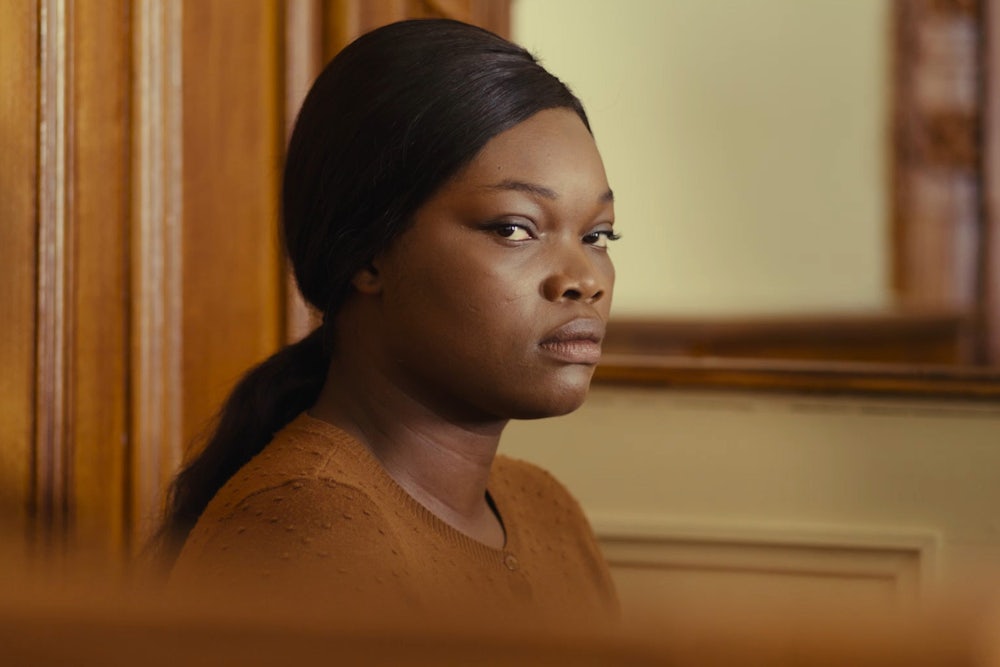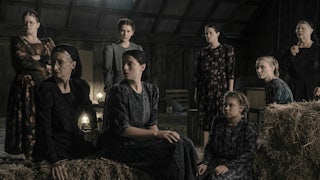Despite her last name, Alice Diop was not destined to become a filmmaker. She is not related to the prominent Diop family, which includes postcolonial auteurs Djibril Diop Mambéty (who made Touki Bouki) and his niece Mati Diop (Atlantique). Alice Diop, whose film Saint Omer was France’s Oscar entry for the international feature category, grew up in the Cité des 3000 housing projects in Aulnay-sous-Bois, a working-class suburb just north of Paris, dotted with factories. “French society educates you to leave these areas,” Diop told Caitlin Quinlan of Reverse Shot magazine in 2022.
A model student, Diop did just that, leaving the banlieue for Paris, first to attend the Sorbonne and then France’s prestigious film school, La Fémis. In her work, she began to make films that seemed to interrogate that very journey, from margin to center, from bottom to the top, and the cruelty of aspiration in a racially stratified society like France’s. In 2011, she made The Death of Danton, a documentary about a young Black actor from her housing project who had been accepted into a prestigious conservatory in Paris only to be typecast in roles like “slave” and “driver.” Her 2021 film, Nous (We), traced the lives of people from the suburbs along the commuter rail into Paris, from white aristocrats preparing for a hunt to a car mechanic from Mali, who confides in his mother, “They’re mean to us.”
Diop experienced her departure from Aulnay-sous-Bois, just 30 minutes by train from the Sorbonne, as both a forced and a voluntary exile, a cleaving wherein she was handed a knife by French society but pressed down with her own hands. “All of my films,” she told Quinlan, “really reside in this guilt that I feel of having, for a time, integrated this French injunction of separating myself from working class neighborhoods.”
Dislocation is, lest we forget, also the story of Euripides’s Medea, a princess uprooted from her homeland of Colchis (modern Georgia) and brought by her husband, Jason, to Greece, where she is regarded suspiciously as a foreign sorceress, a “barbarian” with “black looks.” Medea is better remembered for murdering her sons in an act of revenge against her adulterous husband, but in Saint Omer, Diop has brought her full story to bear in a modern retelling of the myth, newly fused into the true story of Fabienne Kabou, a Senegalese woman accused of leaving her baby on a beach to drown in 2013.
In Saint Omer, Kabou is now Laurence Coly (Guslagie Malanda), a philosophy student whose dreams—professional and romantic—are dashed under the weight of French racism. Her teachers openly wonder if European philosophy is a suitable subject for her and give her poor marks. Her lover, an older white sculptor, shuns her publicly. Medea was a powerful sorceress, and here Laurence claims she had been under the influence of black magic. Someone had cursed her surely. What else can explain how this woman so full of promise—“she talks in very sophisticated French,” the newspapers exclaim—could have committed such a monstrous, unspeakable act?
Diop portrays Laurence as a woman whose parents’ ambitions required she leave Senegal for France, and who, in that very escape, came to be trapped. Much of the film takes place in the town of Saint Omer, where she is standing trial. It is only a courtroom drama in the most literal sense. The testimonies contained within Saint Omer give it a polyphonic quality, allowing Diop to tell Laurence’s story as one of many castaways, daughters handed over to the arms of the sea, to the rising tides of aspiration. Some don’t make it. Some do and don’t look back at the shore. Others, like Diop, occupy a torturous middle ground, restless with the question of whether “making it” was worth a journey that leaves so many others at the bottom of the sea.
We follow the events of the film through Rama (Kayije Kagame), a French Senegalese writer who watches Laurence’s case from the courtroom gallery with more anxiety than the accused. How close was she to being that little girl left on a cold beach in northern France, taking her last breath with no one but the moon left to witness? This is a film about mothers and daughters, and the drama of Laurence’s case is interspersed with flashbacks from Rama’s point of view, snapshots of her mother staring sullenly in a mirror, longing for a life before France, before motherhood and all the sacrifices that come with it.
We know these sacrifices were worth it, that Rama turned out OK, because in one of the first scenes of the film, she is lecturing in a tony university hall on Alain Resnais’s Hiroshima Mon Amour. She is a well-dressed professor, and her students, almost all white, are hanging on to her every word about the nature of art. This is a vision of success, and Diop will shortly show us how much havoc it has wreaked on its bearer.
In her lecture, Rama is reflecting on a real phenomenon, depicted in the film, in which French women who had sex with Nazi occupiers were publicly stigmatized and forced to shave their hair. Marguerite Duras, who wrote the screenplay, “uses the power of her narrative to sublimate reality,” turning these women, mired in shame, into humans “in a state of grace,” Rama explains. This is how we know that Rama, who shortly thereafter makes her way to Saint Omer to cover the trial, is likely plotting to do the same for Laurence—to turn this most reviled figure, a Medea, into a work of art. She plans to call the project Medea Castaway, but her agent is worried people won’t get the reference. “Doesn’t everyone know the story of Medea?” she asks him, taken aback. Is it a bad sign that she, who is with child, had that reference at her fingertips?
Rama is an overachiever, who has come to the trial prepared, but what she encounters stuns her. Throughout the courtroom scenes, Kagame does not much sit in her seat as remain pressed against it, as if awe were a wind pinning her to the nearest surface. Laurence’s depravity is matched only by her elegance. She performs lyrical monologues that sound fully formed; she pauses only for dramatic effect, never just to gather herself. When the judge (Valérie Dréville) asks Laurence why she killed her child, she responds that she does not know and adds, without stopping to think: “I hope the trial will give me the answer.” When the prosecutor reprimands her for her “persistent ambiguity,” she responds: “Some things, we can’t be clear about.”
Only in the trial is Laurence able perhaps to achieve what she longed for when she first came to Paris. “I wanted to leave my mark,” she tells the judge. “I dreamed of being a great philosopher.” In class, she struggled, at least on paper, or so a professor testifies. Yet is this a fair assessment? The same professor testifies she found it odd that Laurence, an African woman, became interested in the philosopher of language Ludwig Wittgenstein: “Why not someone closer to her own culture?”
Laurence’s mother, Odile (Salimata Kamate), tells the court her daughter must be cursed, as “nothing else could explain her failure.” Yet is racism itself not a kind of witchcraft, one that can turn a genius like Laurence into a supposedly underperforming student? Throughout the film, we are exposed to discrepancies between oral and written accounts, a common occurrence in trials but one with broader implications in a postcolonial context. Here, paper—records, tests, diplomas—becomes the colonizer’s magic wand.
But Laurence’s suffering does not win Rama’s unqualified sympathy. We see her visceral disgust at Laurence’s crime (and at Odile’s pride in her daughter’s elegant conduct at trial): It’s not only morning sickness that makes Rama rush to the toilet to throw up her lunch. Laurence is a victim, of course, of French society, of her lover’s shame at having a mixed-race child with a Black mistress, of a self-hating mother enamored by all things French—and that might be enough to sway the well-meaning white people in the courtroom who tear up by movie’s end. But Rama does not absolve Laurence of agency; to do so, after all, would simply be another form of racism. She cries in horror, as the situation demands.
Outside the courtroom, she has an encounter with Odile. The only two Black women there to hear the trial, they form a natural if fleeting bond. They agree to lunch, during which Odile expresses disappointment at Laurence’s rare loss of temper that morning in court. “Education and politesse are the two most important things,” she says over her meal. Her daughter must always show that “she was well brought up.” The woman is ghastly, and yet, at that moment, she looks at Rama and guesses she’s pregnant. It’s one of the most disquieting scenes in the film. What can account for her intuition? Witchcraft? One hopes so, for the alternative—motherly instinct—is too upsetting to contemplate from someone who maybe didn’t drown her daughter, but hoped the tide would sweep her up all the same.
Euripides’s choice to emphasize Medea’s foreign-ness has made his play a useful vessel for postcolonial reinterpretation. Countless retellings of Medea have reframed her “barbarian” status as a foreign princess among the Greeks along modern racial and colonial lines. In a South African reworking by Guy Butler, she is a Tembu princess seduced by the Jason figure, now a British settler named Jonas, in the 1820s. In Jim Magnuson’s African Medea (1968), she is a Bono princess to Jason’s Portuguese slave trader and ivory hunter. In Cherríe L. Moraga’s The Hungry Woman: A Mexican Medea (1995), she is a revolutionary who helps win an independent Chicano state. In Saint Omer, the need to understand what could drive a woman to this unspeakable crime becomes a way for everyone in Laurence’s life to testify to the injustices she has faced and the cruelty she has endured.
Yet Diop resists the temptation to let Laurence off the hook altogether, to attribute her actions and motivations solely to mistreatment. To do so would be to deprive her of her humanity, as represented by her capacity for senseless violence, and her artistry. Toward the end of the film, Rama is watching Pier Paolo Pasolini’s Medea (1969), starring Maria Callas in the title role. She stops at the pivotal scene, the murder, and gasps when she sees it: the moon. It is the same moon that Laurence has been describing in court, the light in the sky that illuminated the path to the beach where she laid her daughter to die. Rama is shocked. Had Laurence seen this scene before? Did she use it as a reference, as if her crime were a student film?
Laurence’s mother pushed her toward France and all it symbolized; she wanted her to become a sophisticated European woman. Well, Medea’s story, it bears remembering, is a European myth. Laurence studied the culture it sprang from like an obedient daughter, and imbibed all of its violences. She was, in the end, sunk by the very life raft her mother swore would save her.






